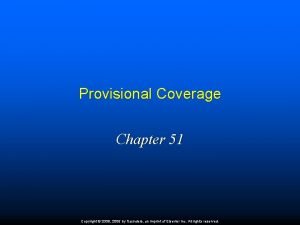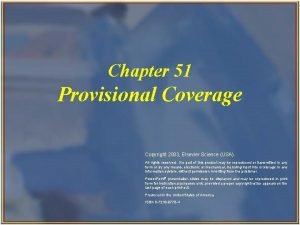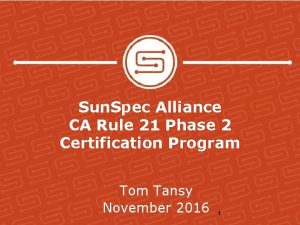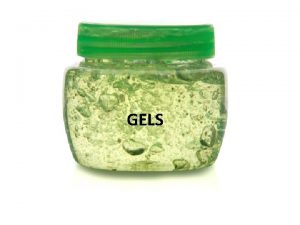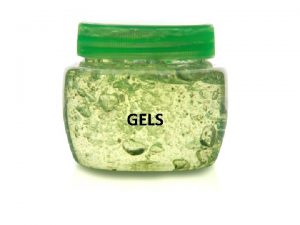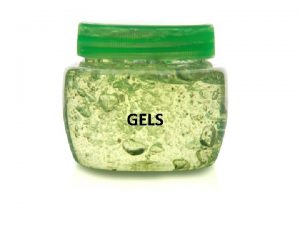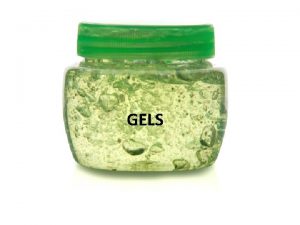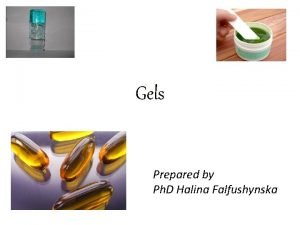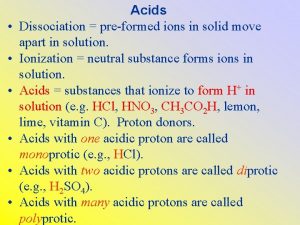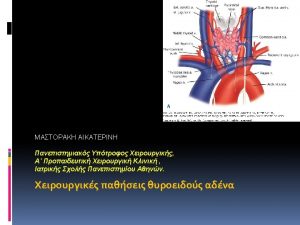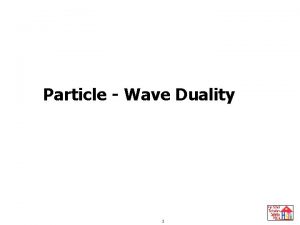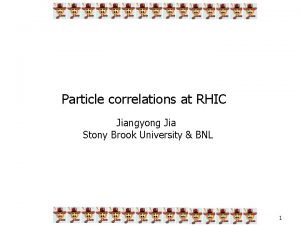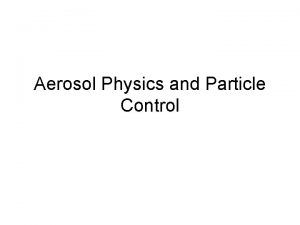Novel Preformed Particle Gels for Conformance Control Jia




















- Slides: 20

Novel Preformed Particle Gels for Conformance Control Jia Zhou Advisor: Dr. Baojun Bai

Outline • Motivation and Objective • Strategy of PPG Synthesis for Conformance Control • Preliminary Results • Future Work and Summary

Motivation Reservoir Model I Permeability k 1 ≈ k 2 > k 3 (e. g. 20 md) k 1 (e. g. 200 md) k 1 Bypassed Oil k 2 (e. g. 200 md) Water Thief Zone in an oil reservoir Near Wellbore k 2 Deep within the reservoir Water can break through from the water injection to the oil production wells in the most permeable zones while significant oil is left in the reservoir. Arrows indicate water flooding directions.

Motivation Reservoir Model II Permeability k 1 >> k 2 >k 3 (e. g. 20 md) k 1 (e. g. 100 D) k 1 Bypassed Oil k 2 (e. g. 200 md) Water Thief Zone in an oil reservoir Near Wellbore k 2 Deep within the reservoir Water can break through from the water injection to the oil production wells in the most permeable zones while significant oil is left in the reservoir. Arrows indicate water flooding directions.

Objective 1. Incremental Recovery by Micro/ Nano Scale Swelling-retarded Gel (SRPG) Treatment – In-depth Mobility Control Technology Bypassed Oil k 3 k 2 Near Wellbore Deep within the reservoir Black arrows indicate water flooding directions. micro/nano scale swelling-retarded particle gels (SRPG).

Objective 2. Further Incremental Recovery by Degraded Particle Gels (DPG) 1. Initial incremental recovery with novel bulk gels k 3 k 1 k 2 Novel degradable particle gels. Small particle gels is feasible in-depth since the permeability(k 2) deep within the reservoir is much lower than that (k 3) near wellbore. Particle gels degraded into colloids in micro scale and diffused into deep reservoir.

Types of Polymer Gels/ Superabsorbents 1. In-situ Gels Philips first applied polymer gels (partial hydrolyzed polyacylamide) for conformance control in the 1970 s. Since then, research into gelling systems has been maintained at an intense level. Pre-gel: gelant Crosslinking begins Gel formation as cross-linking molecules (red) connect polymer molecules (purple).

Types of Polymer Gels/ Superabsorbents 2. Preformed Gels • Advantages : ü Overcome distinct drawbacks inherent in in-situ gelation system such as uncontrolled gelation time, variations in gelation due to shear degradation, gelant composition change due to contacting reservoir minerals and fluids, ü Remain stable with strength- and sized controlled, and environment friendly. ü Enter into fractures or fracture-feature channels first ü Contain one component: simple process ü Include produced water during preparation to save fresh water and protect our environment

Currently Developed Preformed Gels ü Preformed particle gels in mm-size applied in more than 2000 wells (Li, 1999; Coste, 2000; Bai, 2004 and 2007) ü Bulk gels and partially preformed gels (Seright, 2004; Sydansk, 2004 and 2005) ü Microgels injected in one gas well (Chauveteau, 2001 and 2003; Rousseau 2005; Zaitoun 2007) ü Swelling polymer grains in mm-size used to control CO 2 breakthrough (Pyziak, 2007; Larkin 2008; Abbasy, 2008) ü Bright Water® in mm size proceeded more than 10 wells (Pritchett, 2003; Frampton, 2004)

Methods of Gels Synthesis 1. Solution Polymerization Process Pre-gel: gelant Crosslinking begins Gel formation as cross-linking molecules (red) connect polymer molecules (purple).

Methods of Gels Synthesis (con’d) 2. Water-in-oil Emulsion Process Elevate temp Water: Polymer precursor Polymer gel

Experimental Procedures • Solution Polymerization Method Polymer precursor crosslink Gels with two polymer phases Gel Particles in micro-size dry, grind Polymer gels particles Elevated temp. absorb 1% brine Swollen Polymer gels

1. Swelling-retarded Particle Gels (SRPG) Optical microscope image of SRPG in micro size.

SRPG Swelling Ratio Study Different particle gels swell at room temperature. Conventional Preformed Particle Gel. SRPGs swell at 40 o. C after completely swelling at room temperature.

Possible Mechanism of SRPG Degradable polymer shell Polymer gels

2. Degradable Particle Gels (DPG) Optical microscope image of dry Gel I particle, which is like individual crosslinked polymer aggregation.

Possible Mechanism for Degradable Particle Gels Particle gels in mm-size Novel bulk gels Heat Bulk Gel formed with non-labile polymer phase (red) and labile polymer phase (blue). Heat triggers labile polymer dissolved. Therefore, bulk particle gels turn into small particle gels.

Future Work 1. Carry out thermal stability and core flooding studies for both gel particles. 2. Employ high resolution ESEM or ETEM to get more microstructure information of gel particles in both swollen state and dry state. 3. Optimize gel particle properties and synthesize these particle gels through water in oil emulsion process.

Summary • Two types of preformed particle gels have been obtained: Swelling-retarded Particle Gels (SRPGs) and Degradable Particle Gels (DPGs). • Each particle gel targets on specific reservoir condition. • A third type of Degradable Polymer Gels will be developed for in-depth mobility control.

Questions?
 Roofing parapet wall
Roofing parapet wall What are the types of provisional coverage?
What are the types of provisional coverage? What is the purpose of provisional coverage?
What is the purpose of provisional coverage? Conformance to requirements
Conformance to requirements Cost of conformance
Cost of conformance Hci user interface
Hci user interface Oam conformance testing
Oam conformance testing Ponc price of non-conformance
Ponc price of non-conformance Goalpost conformance
Goalpost conformance Peak conformance
Peak conformance Conformance and compliance
Conformance and compliance Ca rule 21 certification
Ca rule 21 certification Conformance framework
Conformance framework Harmony hui
Harmony hui Ni jia you ji ge ren
Ni jia you ji ge ren Zai jia
Zai jia Translate image
Translate image Ye qiu
Ye qiu 8hui jia.com
8hui jia.com 2ming2
2ming2 Jiangyong jia
Jiangyong jia

